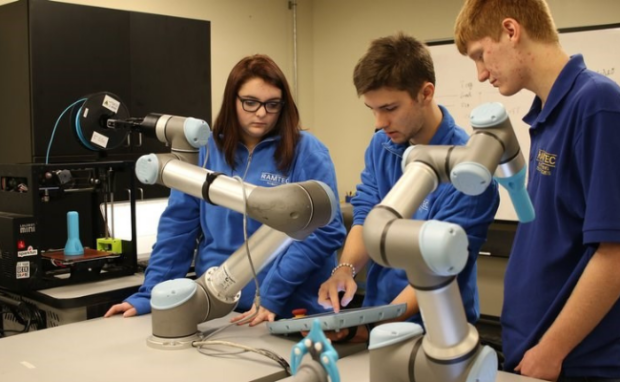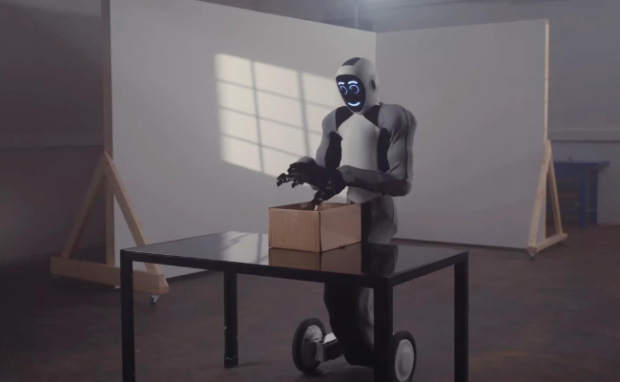MIT develops faster robot training method
Massachusetts Institute of Technology researchers developed a way to train robots faster. Andi Peng, electrical engineering and computer science grad student, says the new method helps robots learn from their mistakes. As a result, experts spend significantly less time training a machine to perform tasks.
Follow the Inquirer Tech channel long enough; you’ll see it has been discussing robotics research more frequently than ever. Nowadays, more companies like Tesla want to manufacture robots to assist customers with mundane tasks like household chores. This research could bring us closer to that futuristic, robotic future!
This article will discuss how MIT’s new robot training technique works. Later, I will cover other robotics projects to illustrate how far we have been developing autonomous machines.
How does the robot training framework function?

Photo Credit: universal-robots.com
The Massachusetts Institute of Technology provided a layman’s explanation of the project and a few statements from the research team. It solves the common robot training problem of machines failing to recognize objects.
The MIT article cites a robot trained to pick up mugs as an example. Most robot developers would spend countless hours ensuring the machine can detect and grab mugs.
The usual dilemma is the robot might only recognize the mug available at the laboratory! If the researchers only used white mugs, they may not recognize blue or green ones.
In MIT’s case, their robot failed to pick up a brown mug with the campus mascot, “Tim The Beaver.” Andi Peng, an MIT graduate student, says most robot engineers would go back to the drawing board without understanding why their machine failed.
“Right now, the way we train these robots when they fail, we don’t really know why,” Peng stated. “So you would just throw up your hands and say, ‘OK, I guess we have to start over.’”
“A critical component that is missing from this system is enabling the robot to demonstrate why it is failing so the user can give it feedback,” she added. Consequently, Peng and her colleagues created a framework that lets humans teach a robot quickly with minimal effort.
You may also like: Netflix posts listing for $900,000 AI job
It uses an algorithm that describes what must change for the robot to perform a task successfully. If we use our previous example, the robot only recognizes white mugs.
The algorithm shows these factors to a person so that they can refine their robot. It is similar to how humans recognize dogs, no matter their breeds.
Like the MIT robot training, our brains have frameworks called schemas. Our minds can recognize traits that define a dog instead of remembering every breed.
What are the other robotics advancements?

Photo Credit: nypost.com
Many companies want to create robots that we can use daily. Imagine applying MIT’s robot training method to these projects, and you’ll see how fast we could have a “sci-fi” future!
For example, you recognize OpenAI as the world-famous ChatGPT bot, but did you know it is developing robots, too? In April, it invested $23.5 million in the Norwegian robotics firm 1X to create ChatGPT robots.
OpenAI is working on two models: EVE and NEO. The former is a humanoid robot with wheels for legs controlled remotely by a human. It has hands that can move and manipulate objects without breaking them.
It can recognize an object’s texture to ensure it won’t deform it. As a result, it could enable people to perform manual labor via remote work. Meanwhile, the NEO robot will have ChatGPT integration.
You may also like: The top 10 AI careers for non-techies
Soon, it could become smart enough to follow voice commands. For example, you can ask a robot to “Find out where I can warm up my lunch.” In response, it will point to a nearby microwave oven.
Korean scientists recently debuted the first-ever humanoid robot pilot called Pibot. Similar to NEO, it can memorize flight manuals using ChatGPT.
More importantly, it has limbs and fingers for operating cockpit controls. Also, its voice integration enables it to communicate with flight crews and serve as a first mate or main pilot.
Conclusion
Massachusetts Institute of Technology researchers developed a new way of training robots. Their framework points out a robot’s problems so humans can solve them.
Consequently, engineers can correct their machines quickly instead of performing numerous trials and errors. More importantly, it could significantly boost robotics development worldwide!
The MIT method can facilitate training autonomous machines to become push them to market quicker. Learn more about the latest digital tips and trends at Inquirer Tech.